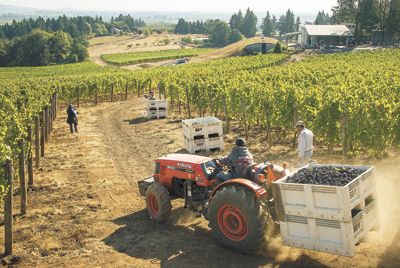2013 ALMANAC:
All in Flavor, Say Yum

By Karl Klooster
With harvest and crush complete, it’s inevitable that talk has begun in earnest about the merits and demerits of the 2012 vintage.
While many of the wines are still in the process of completing ML — or secondary fermentation during which malic acid undergoes conversion to lactic acid, softening the overall taste impression — some are saying this is a year that will ultimately prove to be right up there with the best ever. Others prefer to take a wait-and-see approach, cautioning that early enthusiasm is often over-optimistic.
But the evolving scenario would indicate that a discussion of whether or not this may or may not be one of Oregon’s greatest vintages is almost irrelevant. Why? It’s all about the way the wines taste. Winemakers around the state are nothing short of ecstatic about flavor profiles, particularly in Pinot Noir. And that alone may be all this vintage needs to be called great.
Since the vast majority of Oregon wineries hang their hats on Pinot, as goes the noble Burgundian grape, so goes the wider impression of the industry.
Although a Pinot-centric approach ignores the different varietal emphasis embraced by some wineries, the dominance of the grape is inescapable.
If decison-makers beyond our own borders perceive that 2012 is a great Pinot year in Oregon, that perception will be beneficial for the industry statewide. The adage “A high tide lifts all boats” applies.
And the excitement expressed about the quality and character of the vintage, with particular enthusiasm in regard to flavors, would make anyone a believer. Here is just a sampling of quotes from a cross-section of well-known winemakers:
“Everything came in beautifully. The flavor profiles are rich and silky. I would compare it to 2008” —Don Crank, Willamette Valley Vineyards, Turner.
“A later harvest and also a great harvest. Light cluster weights limited the quantity. But I attribute the high, and I do mean high, quality fruit to this lack of size. Good skin-to-juice ratio, fantastic color, flavor and a balance only achieved in the best of vintages.” —Steve Anderson, Eola Hills Wine Cellars, Rickreall.
“Phenomenal quality. Flavor profiles are amazing. This was a welcome reprieve from the last few years. But that challenge was valuable for all of Oregon; it added to our knowledge of how to make good wines under a variety of difficult conditions.” —Joe Dobbes Jr., Dobbes Family Estate, Dundee.
“This was a seamless vintage. Potentially one of the best. The flavors are concentrated, silky and already approachable. Maybe as good as 2008.” —Laurent Montalieu, NW Wine Company, Dundee.
“Everything came in quickly. Quantity was down a bit. Really nice flavors. Ripe and juicy. The wines just taste terrific. And site-specific character is definitely showing through.” —Dave Paige, Adelsheim Vineyard, Newberg.
“We get fruit from all the Oregon appellations. Cluster weights were 60 percent of normal. The grapes were very concentrated. Everybody is really excited about overall quality. The wines are nicely balanced with ripe, pretty flavors.” —Ken Johnston, 12th & Maple, Dundee.
“I got here in 2001 and have never seen a vintage as spectacular as this. We picked on both sides of the rain. The earlier harvest for our sparkling wines resulted in both good flavors and balanced acidity. The fruit came in perfectly. We didn’t have to do much; just let Mother Nature do her thing.” —Andrew Davis, Argyle Winery, Dundee.
“We’re really excited about the fruit from our sources from around the state. There are some quantity losses, particularly for Pinot Gris, but the quality is outstanding.” —Ryan Harms, Union Wine Co.
So how does the obvious advantage of such seductively appealing, upfront flavors translate in the marketplace?
The overriding reality is that at least 90 percent of wines at all levels of quality are purchased and consumed shortly after release. Only a tiny quantity ever reflects the benefits of cellaring.
Therefore, any enhancements or detractions that additional time in the bottle might bring are not a consideration for the vast majority of wine drinkers. They drink them young and get what they get.
Evaluating mature wines is essentially an exercise undertaken and, I might add, regarded with eager anticipation and thoroughly enjoyed by industry experts and aficionados.
They are among the very few with access to aged bottles pulled out five, ten or more years later. Those few of well-tuned palates and a depth of experience are best able to properly appreciate such enological gems.
Meantime, given the experts’ take on 2012, more average human beings who take pleasure in good fermented grape juice will likely appreciate the fact that they’re getting an exceptional here-and-now taste treat.










